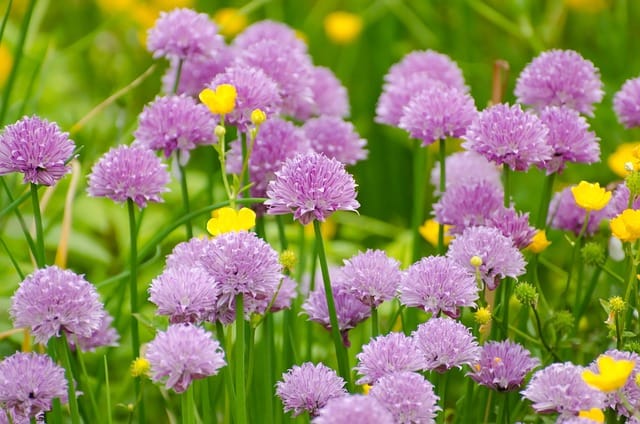How to grow Chives
Welcome to this comprehensive guide on growing chives! Chives (Allium schoenoprasum) are a popular herb known for their culinary uses and attractive appearance

In this article:
- Introduction
- Choosing the Right Variety of Chives
- Selecting a Suitable Location for Growing Chives
- Preparing the Soil for Chive Cultivation
- Propagation Methods for Chives
- Planting Chives from Seeds
- Starting Chives from Transplants
- Proper Watering Techniques for Chives
- Fertilizing Chives for Optimal Growth
- Common Pests and Diseases Affecting Chive Plants
- Pruning and Harvesting Chives
- Preserving and Storing Chives
- Culinary Uses for Chives
- Companion Planting with Chives
- Frequently Asked Questions about Growing Chives
- Conclusion
Introduction
Welcome to this comprehensive guide on growing chives! Chives (Allium schoenoprasum) are a popular herb known for their culinary uses and attractive appearance. They are easy to grow and can be a delightful addition to any garden or kitchen window. In this article, we will cover everything you need to know about growing chives successfully.
Choosing the Right Variety of Chives
Chives come in different varieties, and it is essential to choose the one that best suits your needs. Some common varieties include Common Chives, Garlic Chives, and Siberian Chives. Consider the flavor, appearance, and growth habit of each variety before making your selection.
Selecting a Suitable Location for Growing Chives
Chives require a location that receives at least six hours of direct sunlight every day. Choose a spot with well-drained soil and good air circulation. Avoid areas with excessive shade or waterlogged soil, as these conditions can negatively impact the growth of your chive plants.
Preparing the Soil for Chive Cultivation
Before planting, it is essential to prepare the soil adequately. Chives prefer soil that is rich in organic matter, well-draining, and slightly acidic to neutral (pH 6.0-7.0). You can improve the soil by adding compost or well-rotted manure. Remove any weeds or debris from the planting area.
Propagation Methods for Chives
Chives can be propagated either from seeds or transplants. Both methods have their advantages, and the choice depends on your preference and availability.
Planting Chives from Seeds
If you choose to start chives from seeds, sow them directly into the prepared soil after the last frost date in your area. Sow the seeds thinly and cover them with a thin layer of soil. Keep the soil consistently moist until the seeds germinate, which usually takes around 7 to 14 days. Thin the seedlings to give them enough space to grow.
Starting Chives from Transplants
Alternatively, you can purchase chive transplants from a nursery or start them from divisions. Transplants provide a quicker and more convenient way to establish chive plants. Dig a hole in the soil, place the transplant inside, and cover the roots with soil. Water the plant thoroughly after planting.
Proper Watering Techniques for Chives
Chives require regular watering to keep the soil moist but not waterlogged. Water the plants deeply, allowing the soil to dry slightly between waterings. Avoid overwatering, as it can cause root rot and other problems. Consider using mulch to retain moisture and prevent weed growth.
Fertilizing Chives for Optimal Growth
Chives are not heavy feeders, but they can benefit from a balanced fertilizer applied during the growing season. Use a slow-release fertilizer or organic alternatives like compost or well-rotted manure. Follow the package instructions or apply a small amount of fertilizer around the base of each plant every few months.
Common Pests and Diseases Affecting Chive Plants
Chives are generally pest and disease resistant, but they can still encounter some issues. Common pests include aphids, thrips, and onion flies. You can control these pests by using insecticidal soap or natural predators like ladybugs. Diseases like fungal leaf spots and root rot can be prevented by practicing good sanitation and avoiding overwatering.
Pruning and Harvesting Chives
To encourage healthy growth and continuous production, it is important to prune your chive plants regularly. Remove any dead or yellowing leaves to maintain the overall appearance of the plant. When it comes to harvesting, you can snip the chive leaves with a pair of scissors. Leave at least two inches of growth to allow the plant to continue regrowing.
Preserving and Storing Chives
If you have an abundance of chives, you can preserve them for later use. One popular method is freezing chopped chives in an ice cube tray with water or oil. Alternatively, you can dry them by hanging the cut bunches upside down until they are completely dry. Store dried chives in an airtight container in a cool, dark place.
Culinary Uses for Chives
Chives have a mild onion-like flavor and are commonly used in various culinary dishes. They can be added to salads, soups, omelettes, and cream-based sauces. Chive flowers are also edible and make an attractive garnish. Experiment with different recipes to explore the versatility of this herb.
Companion Planting with Chives
Chives are excellent companion plants for many vegetables and herbs. They repel pests like aphids and attract beneficial insects such as bees and butterflies. Plant chives alongside tomatoes, carrots, broccoli, and roses to enhance the growth and health of these plants.
Frequently Asked Questions about Growing Chives
1. How long does it take for chives to grow?
2. Can chives be grown in containers?
3. How often should chives be divided?
Conclusion
Growing chives is a rewarding experience that can provide you with a fresh supply of this versatile herb. By following the tips and techniques outlined in this guide, you can ensure successful chive cultivation in your garden or indoor space. Enjoy the flavorful harvests and the beauty of these delightful plants!
